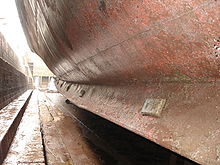Tow test station Bremerhaven
The Bremerhaven towing test station was one of the first shipbuilding test stations in Germany and existed from 1900 to 1914.
prehistory
Before the use of towing research institutes, it was very difficult and inaccurate to predict the propulsion power of ships using theoretical calculations in the period before 1870. This is why the shipbuilding and marine mechanical engineering engineers at the shipyards have so far managed to do simple experimental investigations of scale models. The first simple attempts at this were made in Sweden around 1720 by Charles Sheldon and in France around 1760 by Charles Borda.
Froude's hypothesis
William Froude is considered to be the forerunner of the model tests that are still used today, because the Froude hypothesis laid the basis for converting the model test results to the large-scale version. Froude also founded the first towing device of this kind in England . There the models were towed by a wagon that ran over the towing tank, the necessary towing force was measured and extrapolated to the large version. The transfer of the results to the large-scale version requires a lot of experience and comparative measurements on models of increasing size up to full-size ships (model families, David Taylor). This is how simple research stations became today's research facilities, which are generally referred to as shipbuilding research institutes.
Towing test station Bremerhaven from Norddeutscher Lloyd (NDL)
The large German shipyards and shipping companies around 1900 had an astonishing vertical range of manufacture by today's standards . In addition to the actual hull of the ship, the shipyards also built the propulsion engines, mostly even the auxiliary machinery and the facilities for the crew's quarters. The Hapag shipping company in Hamburg had its own dry dock, as did Norddeutsche Lloyd (NDL) in Bremerhaven. Problems with the delivery of the express steamer Kaiser Friedrich , which Norddeutscher Lloyd had ordered from the Schichau shipyard and which did not reach the contractual speed before delivery, led Norddeutscher Lloyd to set up its own shipbuilding testing facility. After a very short construction period of nine months, Johann Schütte was able to start the tests as early as February 1900. The towing channel had a length of 164 m, a width of 6 m and a water depth of 3.2 m.
Johann Schütte
Johann Schütte, who got a job at the NDL at the end of his studies at the Technical University of Charlottenburg , had, due to his earlier experiments (1899) in the research institute Spezia on the model of the Kaiser Friedrich, the aft ship with the complicated wave exits and wave pants as the cause for the too large Resistances determined. That was one of the main reasons for the ship's slow speed. For this reason, at the Bremerhaven towing test station, he first examined and optimized the aft ship shapes of high-speed steamers, which at that time often had two, three or even four propellers. In 1901 he gave a lecture to the Schiffbautechnische Gesellschaft (STG) in Berlin, which received a lot of international attention.
His resistance tests on curling keels yielded further fundamental findings . In addition to towing tests for the ships of the North German Lloyd, the research institute u. a. also orders from HAPAG, the Reichsmarineamt, von Schichau and the Germania shipyard. In 1911, for example, the largest ships in the world, the passenger steamers of the Imperator class , which even received four propellers, were examined as models at the North German Lloyd. New ship shapes ( Maierform ) were also towed, such as B. for Fritz Franz Maier , who founded the Maierform company . In 1904, Johann Schütte accepted a professorship at the Technical University of Danzig, later he became professor of shipbuilding at the Technical University in Berlin-Charlottenburg, today's Technical University of Berlin.
Johann Schütte later became known for his work on the Schütte-Lanz airships.
Carl Bruckhoff
His successor at the Bremerhaven towing test station was Carl Bruckhoff, who continued his work. The research institute was closed in 1914 because the area was urgently needed for the port expansion. Parts of the equipment were taken over by the Hamburgische Schiffbau-Versuchsanstalt (HSVA).

literature
- Timmermann: The search for the cheapest ship shape . Stalling, Oldenburg 1979
- J. Schütte: Investigations into stern ship shapes . Yearbook of the Shipbuilding Society , Volume 2, 1901
- J. Schütte: The influence of the curling keel on the resistance and rolling movement of ships in calm water , Yearbook of the Shipbuilding Society, Volume 4, 1903



